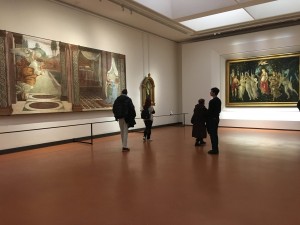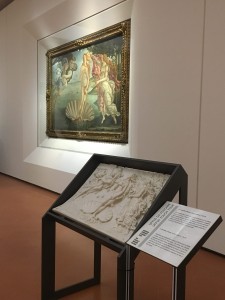
Galleria degli Uffizi, dal 18 ottobre 2016
Di Tania Mio Bertolo ed Elena Zinanni (Università degli Studi di Firenze)
Rumorio, caos e sovraffollamento: queste erano purtroppo alcune costanti del vasto ambiente che ospitava la Primavera e la Nascita di Venere, i due dipinti botticelliani più noti conservati presso la Galleria degli Uffizi. A partire dal 18 ottobre 2016 però, quello stesso ambiente ed alcune altre sale (complessivamente dalla numero 8 alla 15) hanno assunto un nuovo volto che, attraverso un rinnovato assetto architettonico ed espositivo, consente una fruizione più fluida e pausata.
Ultima tappa di un percorso durato poco più di dieci anni, il riallestimento delle Sale del Primo Rinascimento rientra nell’ambizioso progetto dei Nuovi Uffizi, destinato a rinnovarsi negli anni a venire. Nell’ambito di tale progetto la Galleria fiorentina è stata sottoposta a numerosi rinnovamenti che hanno permesso l’ampliamento in termini di metratura del percorso espositivo, il riallestimento di alcune sale e l’inaugurazione di nuovi ambienti, l’esposizione al pubblico di opere d’arte altrimenti conservate nei depositi e la valorizzazione di altre già presenti nel percorso museale. Tra gli altri, si ricorda qui il recente riassetto delle Sale dei Primitivi: penultima e delicatissima tappa che dovette tener conto dell’allestimento di quegli stessi locali eseguito nel secondo dopoguerra dagli architetti Giovanni Michelucci, Carlo Scarpa ed Ignazio Gardella, ancora oggi caposaldo della museografia contemporanea.
Anche per il rinnovo degli ambienti inaugurati lo scorso ottobre è stato scelto un progetto che si pone in continuità ed armonia sia con le vicine Sale dei Primitivi, sia con la stratificazione storica della struttura architettonica. Si ascrive infatti a tale proposito il mantenimento dei materiali e dei colori delle sale storiche, ed anche il recupero e la valorizzazione attraverso lucernari a grandi fori piramidali delle capriate dell’antico Teatro Mediceo, grande volume a doppia altezza progettato nel 1585 dal Buontalenti e corrispondente a buona parte degli odierni spazi del braccio di levante del museo. Nuova e funzionale al diradamento del flusso dei visitatori, è invece la scelta di porzionare l’ambiente destinato ai due capolavori botticelliani (sala 10-14) in due parti comunicanti. Soluzione museografica che consente inoltre sia di valorizzare individualmente i due dipinti, sia di avere al contempo una percezione unica ed unificante di entrambi.
Come già detto, il riassetto architettonico ha permesso anche un riordino nel percorso espositivo delle opere stesse: una sorta di “svuotamento” della principale sala botticelliana per conferire maggiore visibilità ai due capolavori del Maestro, ma anche per valorizzare le altre sue opere attraverso collocazioni espositive più appropriate. Un percorso, quello che principia nella Sala di Masaccio, Paolo Uccello e Filippo Lippi (sala n. 8) e che si conclude nella Sala di van der Goes (n. 15), pensato in maniera efficace per il il visitatore che si voglia accostare gradualmente ai due dipinti cardine della produzione di Botticelli, comprendendo prima gli stili e le maestranze che determinarono la formazione dell’artista, e poi le corrispondenze con la produzione di altri pittori fiorentini e fiamminghi. Uno straordinario gioco di reciproche influenze, regista delle quali è indubbiamente ed unicamente l’arte nelle sue molteplici varianti, ma della valorizzazione delle quali è invece artefice la riuscita scelta espositiva.

The New Rooms of the Early Renaissance at the Uffizi Gallery
Translation by Rachyl Grussing (Istituto Lorenzo de’ Medici)
Murmur, chaos and overcrowding: these were the unfortunate few constants of the fast space that housed the Primavera and the Birth of Venus, the two most famous Botticelli paintings preserved in the Uffizi Gallery. After the 18th of October 2016, however, that same environment and some other rooms (overall the rooms 8 to 15) have assumed a new face, through a renewed architectural and exhibition set-up, allowing for smoother movement and observation of the artworks.
The last leg of the journey that lasts little more than ten years, the rearrangement of the Room of the Early Renaissance is a part of the ambitious project of the New Uffizi, destined to renew itself in the years to come. As part of this project, the Florentine gallery has undergone numerous renovations that have allowed the expansion in terms of the square footage of the exhibition, the rearrangement of some rooms and the inaugurations of new environments and the exposure to the public of works of art otherwise preserved in the deposits and the exploitation of others already present in the museum. Among others, remember here the recent reorganization of the Room of the Primitives: the penultimate and very delicate stage that had to take into account the preparation of those same locations executed after the Second World War by the architect Giovanni Michelucci, Carlo Scarpa and Ignazio Gardella, still today the cornerstone of contemporary museology.
Also for the renewal of the environments inaugurated last October, a design was chosen that was in continuity and harmony with both neighboring Room of the Primitives, and the historical architecture of the building. In fact, it refers to the maintenance of the rooms materials and historical colors, and also the recovery and development through the large double-height pyramidal skylights outside of the trusses of the old Medici Theater, designed in 1585 by Buontalenti and corresponding to a good part of today’s spaces in the east wing of the museum. New and functional to the thinning of the flow of visitors, it chooses to portion the two masterpieces by Botticelli (Rooms 10-14) into two communicating parties. The museological solution also allows for the individual improvement of the two paintings, and also to have a unifying and unique perception of both.
As mentioned, the architectural reorganization allowed for the reorganization of the works in the exhibition: a kind of ‘emptying’ of the main room of Botticelli to give more visibility to the two masterpieces by the Master, but also to enhance the other works through more appropriate collection exhibitions. The route, which begins in the Room of Masaccio, Paolo Uccello, and Filippo Lippi (Room 8) and ends in the Room of van der Goes (Room 15), is effectively designed for the visitor who wants to gradually approach the two pivotal paintings by Botticelli, including the styles and works before who determined the artists training, and then the correspondence with the production of other Florentine and Flemish paintings. In the extraordinary game of influences, the director of which is undoubtedly and exclusively the art in its many variations, but the development of this is a rather successful exhibition choice.